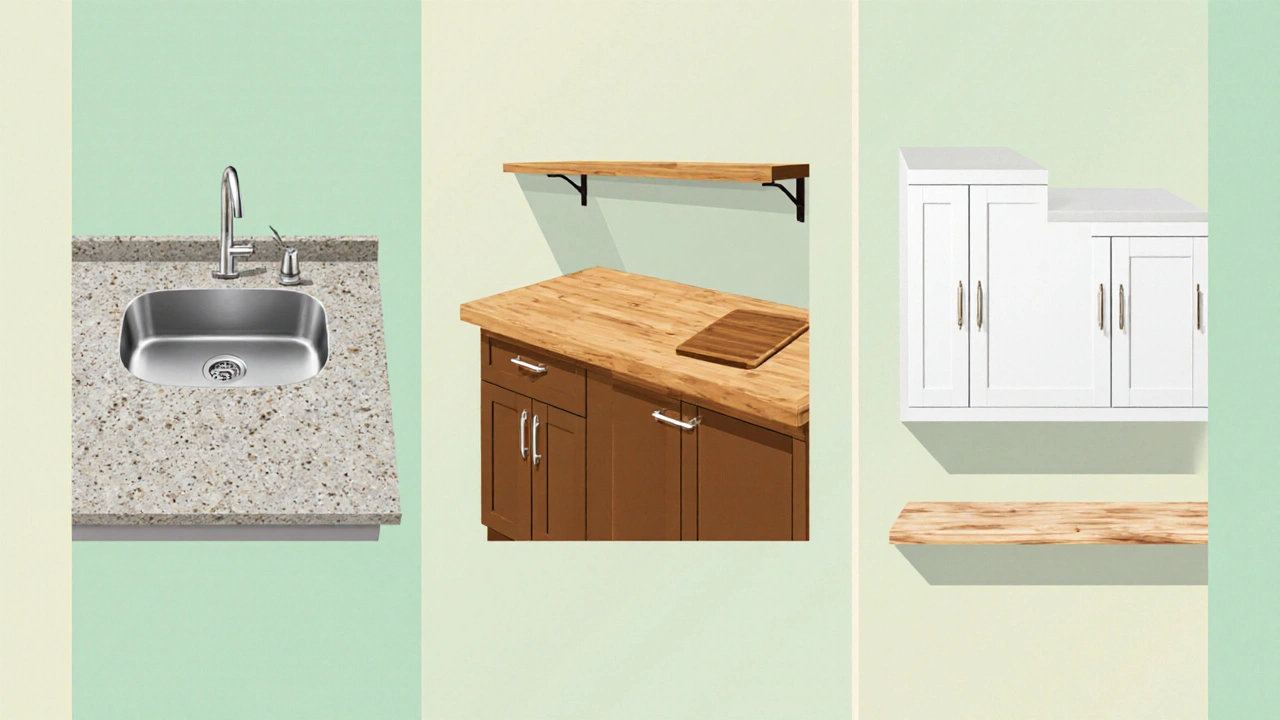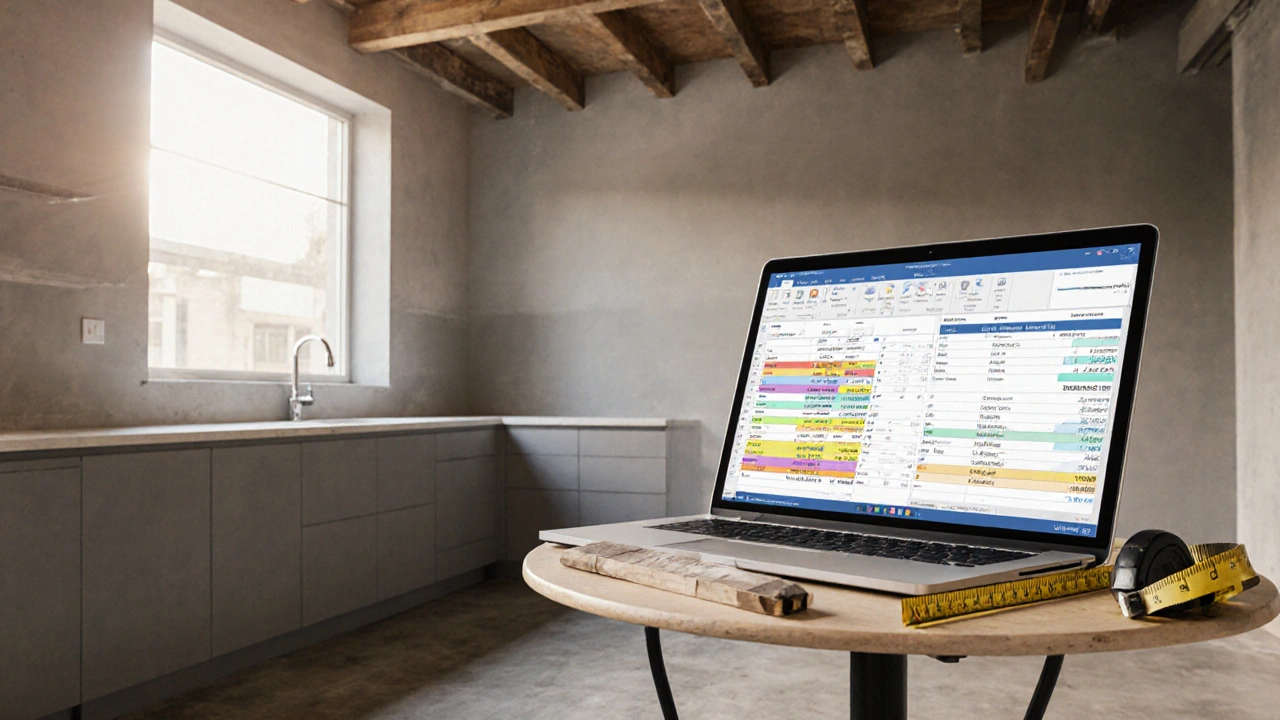Kitchen Remodel Cost Estimator
Breakdown:
- Materials: $0
- Appliances: $0
- Labor: $0
- Permits & Fees: $0
Note: This estimate is based on average costs for 2025. Actual costs may vary depending on location, quality of materials, and local labor rates.
Budget status: Not started
Quick Summary
- Set a realistic budget and stick to it with a detailed spreadsheet.
- Refresh cabinets by painting or adding open shelving instead of full replacement.
- Choose laminate or butcher‑block countertops for a big look with a small price tag.
- Do simple tasks yourself-painting, backsplash, and lighting-to cut labor costs.
- Plan for permits early to avoid surprise fees.
Kitchen remodel is a home improvement project that updates the cooking area’s layout, finishes, and appliances. A well‑planned remodel can boost functionality, resale value, and daily enjoyment without breaking the bank.
1. Define Your Budget and Track Every Dollar
Start with a clear number. Most homeowners allocate 5‑10% of their home’s value to a kitchen upgrade, but a truly cost‑effective approach can stay under $15,000 for a typical three‑person household. Create a simple spreadsheet that splits costs into four buckets:
- Materials (cabinets, countertops, flooring, fixtures)
- Appliances
- Labor (contractor rates, electricians, plumbers)
- Permits and hidden fees
Update the sheet after each purchase. Seeing the numbers in real time stops overspending before it starts.
2. Planning & Design Without Paying a Pro
Free online tools like IKEA Planner, Roomstyler or SketchUp’s basic version let you drag‑and‑drop cabinets, appliances, and flooring. Export a 2‑D floor plan, then walk the space with a tape measure. Look for wasted corners, traffic bottlenecks, and opportunities to add work triangles.
Key design shortcuts:
- Keep the classic work triangle (sink‑fridge‑cooktop) under 26 feet.
- Use a single countertop edge to avoid a costly cut.
- Choose a neutral paint color-light gray or cream-to make the room feel larger without pricey tile.
3. Material Choices That Save Money
Materials make up roughly 40% of a remodel’s cost. Picking the right ones can shave thousands off the total.
| Material | Average Cost | Durability Rating (1‑5) | DIY‑Friendly |
|---|---|---|---|
| Laminate | $30‑$45 | 2 | Yes |
| Butcher‑block (hardwood) | $50‑$70 | 3 | Yes |
| Engineered quartz | $90‑$120 | 5 | No |
| Granite | $80‑$115 | 5 | No |
Laminate and butcher‑block score high on DIY‑friendly and low on price. Pair a laminate countertop with a butcher‑block cutting board for a mixed‑material look that feels upscale.
Cabinet options:
- Paint and refacing: Strip doors, sand, prime, then paint with a semi‑gloss. Adding new hardware costs $5‑$10 per knob.
- Open shelving: Install open shelves using 1‑by‑12 pine planks and simple brackets. It reduces material cost and adds a modern vibe.
- Ready‑to‑assemble (RTA) cabinets from budget retailers-usually $70‑$120 per linear foot.

4. Labor Savings: When to DIY and When to Hire
Roughly half of a remodel’s expense is labor. Identify tasks you can do yourself without compromising safety or code.
| Task | Typical Contractor Cost | DIY Difficulty (1‑5) | Potential Savings |
|---|---|---|---|
| Painting walls & ceiling | $800‑$1,200 | 2 | $600‑$900 |
| Installing backsplash tile | $1,000‑$1,500 | 3 | $800‑$1,200 |
| Electrical fixture swap | $150‑$300 per fixture | 4 (must follow local code) | $100‑$250 per fixture |
| Flooring (vinyl click‑lock) | $1,200‑$2,000 | 3 | $900‑$1,600 |
If you’re comfortable with a drill, a level, and safety gear, painting, installing a tile backsplash, and laying click‑lock vinyl flooring are great DIY wins. For anything involving plumbing or permanent electrical changes, hire a licensed contractor to avoid costly re‑work and code violations.
5. Permits, Inspections, and Hidden Costs
Minor cosmetic upgrades often don’t need permits, but moving appliances, relocating plumbing, or changing electrical circuits does. Contact your municipality-most Canadian cities, including Burlington, allow online permit applications. Budget $150‑$300 for a standard kitchen permit and add 2‑3% of the total project cost for inspection fees.
Other hidden expenses to watch:
- Delivery fees for heavy items (countertops, appliances).
- Disposal of old cabinets and tiles-rental of a dumpster costs $250‑$350.
- Unexpected wall repairs (water damage, mold).
6. Timeline Management and Staying on Track
Map the remodel onto a simple Gantt‑style timeline:
- Week1‑2: Detailed budget, design, and permit application.
- Week3‑4: Order cabinets, countertops, and appliances.
- Week5: Demolition and disposal.
- Week6‑7: Install cabinets, flooring, and plumbing rough‑in.
- Week8: Countertops, backsplash, painting.
- Week9: Install appliances, lighting, and finish hardware.
- Week10: Final inspection and cleanup.
Having a written schedule helps you flag delays early and negotiate with suppliers before prices shift.
7. Final Checklist Before You Call It Done
- All permits signed off and final inspection passed.
- Cabinet doors open/close smoothly; hardware tightened.
- No water leaks at sink or dishwasher connections.
- All electrical outlets test with a voltage tester.
- Countertops sealed (if wood) and tiles grouted evenly.
- Floor transition strips installed where needed.
Cross‑checking each item saves you from costly post‑remodel fixes.
Frequently Asked Questions
How much should I set aside for a budget kitchen remodel?
A realistic range is $12,000‑$20,000 for a mid‑size kitchen if you focus on inexpensive materials and DIY labor. The exact number depends on square footage and whether you move major plumbing.
Can I replace cabinets without a contractor?
Yes, if you use ready‑to‑assemble cabinets or refinish existing ones. You’ll need a drill, level, and a few basic tools. Just make sure the wall studs can support the new weight.
What’s the cheapest countertop that still looks high‑end?
Laminate with a high‑gloss finish mimics stone patterns and costs as low as $30 per square foot. Pair it with a decorative edge to add visual interest.
Do I need a permit for new lighting?
Minor fixture swaps usually don’t require a permit, but adding new circuits or moving wiring does. Check your city’s building code to be safe.
How can I avoid surprise costs during demolition?
Inspect walls for hidden water damage or mold before you start. Budget a contingency of 10% of the total project to cover any unexpected repairs.

